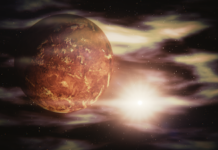In a bid to chart out other galaxies, the scientific community has made a stunning discovery. There has always been speculation in astrological circles that there may be other planets in addition Earth with the potential to support life.
The discovery in focus is a planet that has been named TOI-733b, located some 245 light-years from Earth. This newly discovered planet is larger than Earth and has its own sun. However, unlike our planet, TOI-733b revolves around its star in a paltry five days.
Bizarre Attributes of TOI-733b
The density of the Earth’s crust has been reported by experts to be 5.51 grams per cubic centimeter. The density of TOI-733b is less—3.98 grams per cubic centimeter. But before you get deem it uninhabitable, Mars – which earthlings are trying to populate – is less dense than TOI-733b.
Also, astronomers suggest that TOI-733b is an oceanic planet with surface water like Earth. However, they equally suspect the planet may have lost its atmosphere due to how close it revolves around its sun. Therefore, scientists are speculating that TOI-733b is a bare, shrinking rock.
How to Identify Planets that May Support Life
Over the years, astrological researchers have come to agree that a major prerequisite for a planet to support life is water. So, one of the first clues experts look for during exploration of new planets is the presence of an ocean, either on the surface or underneath.
However, going by TOI-733b’s proximity to its sun, there is a high likelihood that it has lost all its surface water. But, if it turns out to be an oceanic planet, there might still be bodies of water trapped beneath the planet’s crust.
Several Other Planets Promise Inhabitability Potential
Besides TOI-733b, several recently discovered planets and moons have been found to have oceans. As a result, they possess the potential to support life. These celestial bodies are called exoplanets because they exist outside our solar system.
Proxima Centauri B is the closest exoplanet to Earth. Some other examples are TRAPPIST 1e, F and g, Keppler 22 b. Likewise, within our solar system, Europa, Enceladus, and Titan – all planetary moons – show signs of having oceans.
Rules of Engagement
The initial discovery of the potential of many of these celestial bodies is achieved right from Earth by using telescopes and deep probes. However, thorough exploration requires flying missions, manned or unmanned, to some of these celestial bodies.
For the accuracy of data collection during the exploration, organizations around the globe have agreed to avoid the contamination of these newly discovered celestial bodies with microbes from planet Earth. Therefore, the majority of these missions have been unmanned.
Source| oplanet.com
































